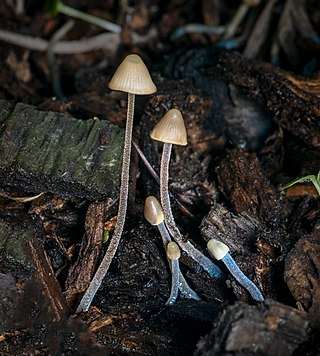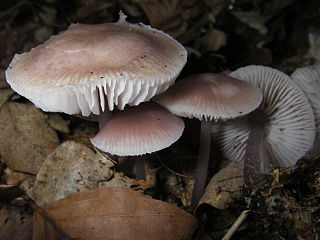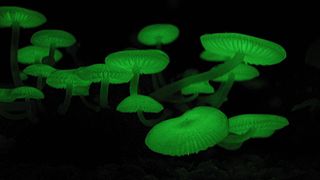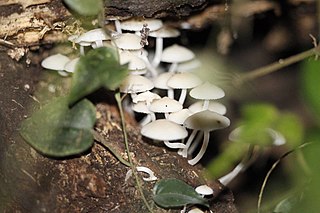
Mycena is a large genus of small saprotrophic mushrooms that are rarely more than a few centimeters in width. They are characterized by a white spore print, a small conical or bell-shaped cap, and a thin fragile stem. Most are grey or brown, but a few species have brighter colours. Most have a translucent and striate cap, which rarely has an incurved margin. The gills are attached and usually have cystidia. Some species, like Mycena haematopus, exude a latex when the stem is broken, and many species have a chlorine or radish-like odour.
Mycena citricolor is a species of mushroom-forming fungus in the family Mycenaceae. It is a plant pathogen producing leaf spots on coffee plants. This fungus causes the disease commonly known as American Leaf Spot. Mycena citricolor affects coffee plants, primarily in Latin America, but can grow on other plants as well. This fungus can grow on all parts of the coffee plant including the leaves, stems and fruits. When grown on the leaves, Mycena citricolor results in leaves with holes that often fall from the plant.

Mycena haematopus, commonly known as the bleeding fairy helmet, the burgundydrop bonnet, or the bleeding Mycena, is a species of fungus in the family Mycenaceae, of the order Agaricales. It is widespread and common in Europe and North America, and has also been collected in Japan and Venezuela. It is saprotrophic—meaning that it obtains nutrients by consuming decomposing organic matter—and the fruit bodies appear in small groups or clusters on the decaying logs, trunks, and stumps of deciduous trees, particularly beech. The fungus, first described scientifically in 1799, is classified in the section Lactipedes of the genus Mycena, along with other species that produce a milky or colored latex.

Mycena polygramma, commonly known as the grooved bonnet, is a species of mushroom in the family Mycenaceae. The inedible fruit bodies are small, pale gray-brown mushrooms with broadly conical caps, pinkish gills. They are found in small troops on stumps and branches of deciduous and occasionally coniferous trees. The mushroom is found in Asia, Europe, and North America, where it is typically found on twigs or buried wood, carrying out its role in the forest ecosystem by decomposing organic matter, recycling nutrients, and forming humus in the soil. M. polygramma contains two uncommon hydroxy fatty acids and is also a bioluminescent fungus whose intensity of light emission follows a diurnal pattern.

Mycena pura, commonly known as the lilac mycena, lilac bonnet, is a species of mushroom in the family Mycenaceae. First called Agaricus prunus in 1794 by Christian Hendrik Persoon, it was assigned its current name in 1871 by German Paul Kummer. Mycena pura is known to bioaccumulate the element boron.

George Edward Massee was an English mycologist, plant pathologist, and botanist.

Mycena epipterygia is a species of fungus in the family Mycenaceae of mushrooms commonly found in Europe. It is commonly known as yellowleg bonnet or yellow-stemmed mycena. The species is saprotrophic and its appearance is quite variable. For example, a number of members of the genus Mycena, some parts of the fungus are bioluminescent, including in this species, the mycelium. Mycena nivicola has been suggested as a separate species name for the Western variety.

Mycena maculata, commonly known as the reddish-spotted Mycena, is a species of fungus in the family Mycenaceae. The fruit bodies, or mushrooms, have conic to bell-shaped to convex caps that are initially dark brown but fade to brownish-gray when young, reaching diameters of up to 4 cm. They are typically wrinkled or somewhat grooved, and have reddish-brown spots in age, or after being cut or bruised. The whitish to pale gray gills also become spotted reddish-brown as they mature. The stem, up to 8 cm (3 in) long and covered with whitish hairs at its base, can also develop reddish stains. The mycelium of M. maculata has bioluminescent properties. The saprobic fungus is found in Europe and North America, where it grows in groups or clusters on the rotting wood of both hardwoods and conifers. The edibility of the fungus is unknown. Although the species is known for, and named after its propensity to stain reddish, occasionally these stains do not appear, making it virtually indistinguishable from M. galericulata.

Mycena chlorophos is a species of agaric fungus in the family Mycenaceae. First described in 1860, the fungus is found in subtropical Asia, including India, Japan, Taiwan, Polynesia, Indonesia, and Sri Lanka, in Australia, and Brazil. Fruit bodies (mushrooms) have pale brownish-grey sticky caps up to 30 mm (1.2 in) in diameter atop stems 6–30 mm (0.2–1.2 in) long and up to a millimeter thick. The mushrooms are bioluminescent and emit a pale green light. Fruiting occurs in forests on fallen woody debris such as dead twigs, branches, and logs. The fungus can be made to grow and fruit in laboratory conditions, and the growth conditions affecting bioluminescence have been investigated.
Mycena asterina is a species of agaric fungus in the family Mycenaceae. It is found in São Paulo state, Brazil, where it grows singly or scattered on fallen leaves in Atlantic forests. The fruit bodies of the fungus are bioluminescent.
Mycena kentingensis is a species of agaric fungus in the family Mycenaceae. Found in Taiwan and described as new to science in 2013, the fruit bodies of the fungus are bioluminescent. Closely related species include M. stylobates and M. adscendens.
Mycena discobasis is a species of agaric fungus in the family Mycenaceae. Found in South America and Madagascar, the fruit bodies of the fungus are bioluminescent.
Mycena fera is a species of agaric fungus in the family Mycenaceae. Found in South America, the fruit bodies of the fungus are bioluminescent.

Mycena illuminans is a species of agaric fungus in the family Mycenaceae. It was first found on the trunk of Calamus (palm) in Jawa, Indonesia.

Mycena zephirus is a species of agaric fungus in the family Mycenaceae. It is bioluminescent.
Mycena sublucens is a species of agaric fungus in the family Mycenaceae. Found in Indonesia, it was described as new to science in 1954 by English mycologist E. J. H. Corner. The fruit bodies are bioluminescent.

Mycena singeri is a species of agaric fungus in the family Mycenaceae. Described as new to science in 1988 by Jean Lodge, it is bioluminescent. In 2007, the first reported luminescent species were found from a single site in primary Atlantic Forest habitat in the Alto Ribeira Tourist State Park, São Paulo State, Brazil.
Mycena noctilucens is a species of agaric fungus in the family Mycenaceae. The species was first described scientifically by E.J.H. Corner in 1954. Found in Malaysia and the Pacific islands, the mycelium of the fungus is bioluminescent.
Roridomyces irritans is a species of fungus in the genus Roridomyces, family Mycenaceae. Originally described from New Caledonia as Mycena irritans by Egon Horak in 1978, the species was transferred to Roridomyces in 1994. The fruit bodies are bioluminescent.











